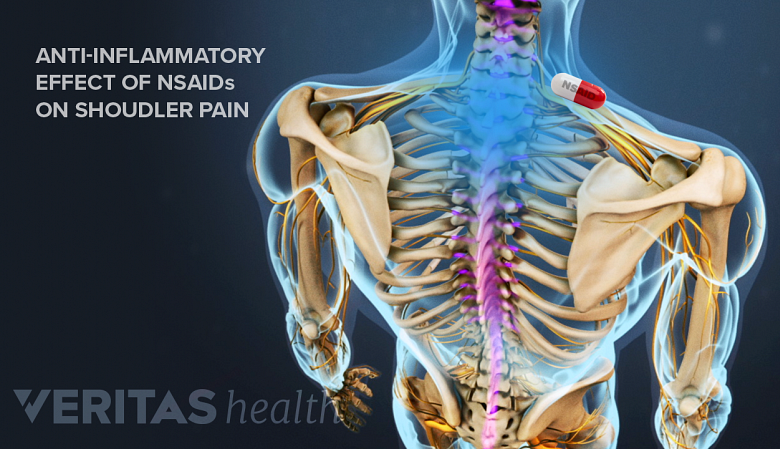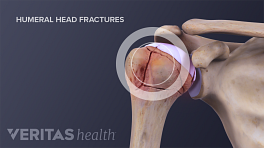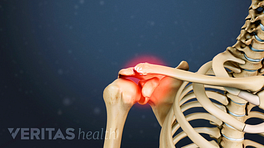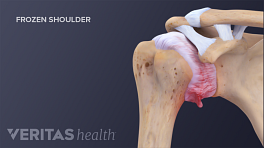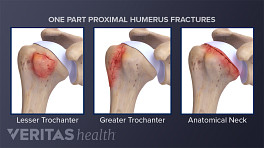Most scapula fractures do not require surgery. Surgery may be required if a fracture displaces bones, forcing them out of their normal positions.
In This Article:
- A Broken Shoulder: Scapula Fracture
- Diagnosing a Scapula Fracture
- Treating a Scapula Fracture
Nonsurgical Treatment
NSAIDs provide anti-inflammatory effects and help calm inflammation and pain in the shoulder.
Examples of nonsurgical treatment include:
- Using a sling or shoulder immobilizer to prevent movement. Shoulder immobilizers may have additional straps and cuffs for the arm, wrist, and fingers for more stabilization. The shoulder is immobilized until the pain diminishes, typically 3 or 4 weeks depending on the type or severity of the fracture.
- Taking pain medication to help reduce pain and swelling. Nonsteroidal anti-inflammatory drugs (NSAIDs) such as naproxen and ibuprofen are commonly recommended, however these medicines are avoided before surgery as they can cause excessive bleeding.
- Regularly icing the affected area to reduce swelling. The ice pack can be covered with a towel or cloth to prevent ice burn.
Watch Video: How to Make 5 Quick and Easy Ice Packs
Rehabilitating from nonsurgical treatment can involve monitoring a person’s pain, inflammation, and posture by a therapist. A strengthening program may also be added. It can take 6 to 12 months to completely restore shoulder motion.
See Acute Injury: Additional Treatment Considerations
Scapular body fractures are typically treated nonsurgically with good results. 1 Greiwe RM. Shoulder and Elbow Trauma and its Complications Volume 1: The Shoulder. Cambridge, UK: Woodhead Publishing; 2015. However, fractures of the scapular neck or glenoid may require surgical intervention. 2 Zlowodzki M, Bhandari M, Zelle BA et al. Treatment of Scapula Fractures: Systematic Review of 520 Fractures in 22 Case Series. J Orthop Trauma. 2006 Mar;20(3):230-3.
Surgical Treatment
In certain cases, surgery to repair a broken scapula is necessary. Surgery for a scapular fracture may be recommended when:
- The angle of the bone causes a deformity in the limb (angular deformity) 3 Ada JR, Miller ME. Scapular fractures. Analysis of 113 cases. Clin Orthop Relat Res. 1991 Aug;(269):174-80.
- The bone positioning is no longer in its correct, anatomical position (displacement) 3 Ada JR, Miller ME. Scapular fractures. Analysis of 113 cases. Clin Orthop Relat Res. 1991 Aug;(269):174-80.
- The glenoid socket is fractured, causing instability of the ball and socket joint
- Additional bones, such as the clavicle, are fractured 4 Cole PA, Freeman G, Dubin JR. Scapula fractures. Current Reviews in Musculoskeletal Medicine. 2013;6(1):79-87. doi:10.1007/s12178-012-9151-x.
See Clavical Fractures: Types and Symptoms
A surgeon may postpone surgery if other injuries have occurred on the same side of the body. 3 Ada JR, Miller ME. Scapular fractures. Analysis of 113 cases. Clin Orthop Relat Res. 1991 Aug;(269):174-80. Since scapula fractures are routinely linked with traumatic events, the course of action often depends on these associated injuries. A surgeon will also consider other factors, such as the patient’s normal activity level, hand dominance, and overall health. 3 Ada JR, Miller ME. Scapular fractures. Analysis of 113 cases. Clin Orthop Relat Res. 1991 Aug;(269):174-80.
See 3 Questions and Answers about Shoulder Blade Fractures
Following surgery, rehabilitation generally involves:
- Wearing a sling to prevent arm movement.
- Physical therapy beginning with mild shoulder motions; more aggressive exercises can be applied about eight weeks after surgery. Resistant exercises are usually added 12 weeks post-surgery.
The physician may recommend working with a physical therapist for rehabilitation.
Any surgery poses some risk, such as nerve and blood vessel damage, bleeding, or infection. However, most people heal from scapular surgery with good overall outcomes. 1 Greiwe RM. Shoulder and Elbow Trauma and its Complications Volume 1: The Shoulder. Cambridge, UK: Woodhead Publishing; 2015. , 2 Zlowodzki M, Bhandari M, Zelle BA et al. Treatment of Scapula Fractures: Systematic Review of 520 Fractures in 22 Case Series. J Orthop Trauma. 2006 Mar;20(3):230-3. , 5 Egol KA, Connor PM, Karunakar MA et al. The Floating Shoulder: Clinical and Functional Results. JBJS 2001.
- 1 Greiwe RM. Shoulder and Elbow Trauma and its Complications Volume 1: The Shoulder. Cambridge, UK: Woodhead Publishing; 2015.
- 2 Zlowodzki M, Bhandari M, Zelle BA et al. Treatment of Scapula Fractures: Systematic Review of 520 Fractures in 22 Case Series. J Orthop Trauma. 2006 Mar;20(3):230-3.
- 3 Ada JR, Miller ME. Scapular fractures. Analysis of 113 cases. Clin Orthop Relat Res. 1991 Aug;(269):174-80.
- 4 Cole PA, Freeman G, Dubin JR. Scapula fractures. Current Reviews in Musculoskeletal Medicine. 2013;6(1):79-87. doi:10.1007/s12178-012-9151-x.
- 5 Egol KA, Connor PM, Karunakar MA et al. The Floating Shoulder: Clinical and Functional Results. JBJS 2001.

